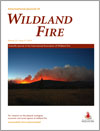International Journal of Wildland Fire
Volume 23
Number 4 2014
The effect of varying wind speed on the transition of surface fire to live shrub crown fuel composed of chamise was studied in an open-topped wind tunnel. Increasing wind speed from 1.5 to 1.8 m s–1 enhanced heat transfer to the crown fuel, promoting crown fire ignition and spread.
This study provides experimental evidence to support the validity of the grey body assumption for vegetation flame emissivity in two important infrared spectral windows.
We present a simple model that separates dry matter and water content changes to explain 85% of the seasonal variation in live foliar moisture content (LMFC) in Pinus contorta. This methodology could be applied across a range of plant functional types to better understand seasonal LFMC variations and their influence on live fuel flammability.
We assessed the moisture dynamics in spruce–feather moss and spruce–Sphagnum organic soil layers during an extreme fire season. We used this information to project the effects of climate change on potential depth of burn in these stands. Results suggest that climate change will increase depth of burn in spruce–feather moss stands, but not in spruce–Sphagnum stands.
The start, peak and end dates of the yearly fire season and its temporal changes were determined. Weather variability and its relationship to changes in fire occurrence and seasonality was also evaluated. The study highlighted the need to advance research on the influence of a changing climate on forest fires in the semi-arid environment of Lebanon.
Wildfires currently represent one of the most critical environmental concerns that Spain has to face. This study aims at evaluating the potential economic savings that can be obtained by the use of a meteorological fire risk index to decide when to adopt fire preventive actions in two zones of Spain.
Negative binomial models predicting the daily number of bushfires occurring within management regions of south-west Western Australia were developed and tested with data from incident records. The models had reasonable fits but did not show enough prediction variation to be of practical use in areas with few fires.
Analysis of 8 years of MODIS active fire detections across the Brazilian tropical moist forest biome indicates that fire is anthropogenic and occurs close to surface transportation networks with 50 and 95% of all MODIS active fire detections within 1 and 10 km respectively of a road or navigable river.
Forest management and protection program budgets are limited, and managers are requesting help to objectively assign their limited protection resources based on environmental characteristics of a site and the available firefighting resources and existing infrastructure. The methodology presented here provides managers with fundamental information for strategic planning and development of tactical operations for resource protection.
We present findings from a survey of the Australian wildland fire sector on the actual and potential role of economics in supporting wildland fire management decisions. Analysis of the survey results informed several recommendations on ways to improve the integration of economics into wildland fire management.
We analyse survey data from a wildland–urban interface community for residents’ willingness to participate in, and pay for, cost shared wildfire risk mitigation. Results suggest residents participate both to address costs and to acquire property-specific information. Risk perceptions positively correlate with participation, but assessed risk levels negatively correlate with participation.
This research investigates the role of place and the challenges and dilemmas confronted by firefighters. Local knowledge can assist firefighters, but can make it more hazardous for local firefighters if they feel compelled to do more because of their ‘responsibility for place’.
A smartphone application to assess the amount of fuel in a wildland–urban interface area was used by volunteers with varying levels of forest measurement experience and the data quality was evaluated. We conclude that the approach was successful and if implemented may lead to improved fire management decision making.
Our research examined the effect of one of the largest wildfires in Californian history on native carnivore species that dwell in chaparral shrublands. We used camera surveys to document the response of coyote, bobcat, gray fox and striped skunk to this wildfire and to rural human residences.




